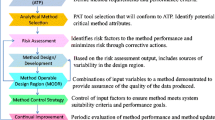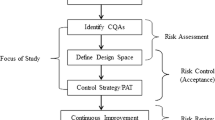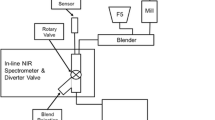Abstract
Process analytical technology has elevated the role of sensors in pharmaceutical manufacturing. Often the ideal technology must be selected from many suitable candidates based on limited data. Net analyte signal (NAS) theory provides an effective platform for method characterization based on multivariate figures of merit (FOM). The objective of this work was to demonstrate that these tools can be used to characterize the performance of 2 dissimilar analyzers based on different underlying spectroscopic principles for the analysis of pharmaceutical compacts. A fully balanced, 4-constituent mixture design composed of anhydrous theophylline, lactose monohydrate, microcrystalline cellulose, and starch was generated; it consisted of 29 design points. Six 13-mm tablets were produced from each mixture at 5 compaction levels and were analyzed by near-infrared and Raman spectroscopy. Partial least squares regression and NAS analyses were performed for each component, which allowed for the computation of FOM. Based on the calibration error statistics, both instruments were capable of accurately modeling all constituents. The results of this work indicate that these statistical tools are a suitable platform for comparing dissimilar analyzers and illustrate the complexity of technology selection.
Similar content being viewed by others
References
Bugay DE, Brittain HG. Raman spectroscopy. In: Brittain H, ed.Spectroscopy of Pharmaceutical Solids. vol. 160. New York, NY: Taylor & Francis; 2006:271–312.
Cogdill RP, Drennen JK. Near-infrared spectroscopy. In: Brittain H, ed.Spectroscopy of Pharmaceutical Solids. vol. 160. New York, NY: Taylor & Francis; 2006:313–412.
Afseth NK, Segtnan VH, Marquardt BJ, Wold JP. Raman and near-infrared spectroscopy for quantification of fat composition in a complex food model system.Appl Spectrosc. 2005;59:1324–1332.
Furukawa T, Masahiro W, Siesler HW, Ozaki Y. Discrimination of various poly(propylene) copolymers and prediction of their ethylene content by near-infrared and Raman spectroscopy in combination with chemometric methods.J Appl Polym Sci. 2003;87:616–625.
Nordon A, Meunier C, McGill CA, Littlejohn D. Comparison of calibration methods for the monitoring of a fluorobenzene batch reaction using low-field 19F NMR, 1H NMR, NIR, and Raman spectrometries.Appl Spectrosc. 2002;56:515–520.
Nordon A, Mills A, Burn RT, Cusick FM, Littlejohn D. Comparison of non-invasive NIR and Raman spectrometries for determination of alcohol content of spirits.Anal Chim Acta. 2005;548:148–158.
Qiao Y, van Kempen TATG. Comparison of Raman, mid, and near infrared spectroscopy for predicting the amino acid content in animal meals.J Anim Sci. 2004;82:2596–2600.
Chung H, Ku M-S. Comparison of near-infrared, infrared, and Raman spectroscopy for the analysis of heavily petroleum products.Appl Spectrosc. 2000;54:239–245.
Ku M-S, Chung H. Comparison of near-infrared and Raman spectroscopy for the determination of chemical and physical properties of naphtha.Appl Spectrosc. 1999;53:557–564.
Lorber A, Faber K, Kowalski BR. Net analyte signal calculation in multivariate calibration.Anal Chem. 1997;69:1620–1626.
Lorber A. Error propagation and figures of merit for quantification by solving matrix equations.Anal Chem. 1986;58:1167–1172.
Brown CD. Discordance between net analyte signal theory and practical multivariate calibration.Anal Chem. 2004;76:4364–4373.
Morgan DR. Spectral absorption pattern detection and estimation, I: analytical techniques.Appl Spectrosc. 1977;31:404–415.
Olivieri AC, Faber NM, Ferre J, Boque R, Kalivas JH, Mark H. Uncertainty estimation and figures of merit for multivariate calibration.Pure Appl Chem. 2006;78:633–661.
Haaland DM. Classical versus inverse least squares methods in quantitative spectral analyses.Spectroscopy. 1987;2:56–57.
Boelens HF, Kok WT, de Noord OE, Smilde AK. Performance optimization of spectroscopic process analyzers.Anal Chem. 2004;76:2656–2663.
Xu L, Schechter I. A calibration method free of optimum factor number selection for automated multivariate analysis. Experimental and theoretical study.Anal Chem. 1997;69:3722–3730.
Ferre J, Brown SD, Rius FX. Improved calculation of the net analyte signal in inverse multivariate calibration.J Chemom. 2001;15:537–553.
Bro R, Andersen CM. Theory of net analyte signal vectors in inverse regression.J Chemom. 2003;17:646–652.
Martens H, Naes T.Multivariate Calibration. New York, NY: John Wiley and Sons; 1989.
Xu L, Schechter I. Wavelength selection for simultaneous spectroscopic analysis. Experimental and theoretical study.Anal Chem. 1996;68:2392–2400.
Goicoechea HC, Olivieri AC. Chemometric assisted simultaneous spectrophotometric determination of four-component nasal solutions with a reduced number of calibration samples.Anal Chem Acta. 2002;453:289–300.
Braga JWB, Poppi RJ. Figures of merit for the determination of the polymorphic purity of carbamazepine by infrared spectroscopy and multivariate calibration.J Pharm Sci. 2004;93:2124–2134.
Geladi P, Kowalski BR. Partial least-squares regression: a tutorial.Anal Chem Acta. 1986;185:1–17.
De Jong S. SIMPLS: an alternative approach to partial least squares regression.Chemom Intell Lab Syst. 1993;18:251–263.
ICH. ICH harmonised tripartite guideline: validation of analytical procedures: text and methodology.Fed Regist. 1997;62:27463–27467.
Haaland DM, Thomas EV. Partial least-squares methods for spectral analyses, 1: relation to other quantitative calibration methods and the extraction of qualitative information.Anal Chem. 1988;60:1193–1202.
Long GL, Winefordner JD. Limit of detection: a closer look at the IUPAC definition.Anal Chem. 1983;55:712A-724A.
Savitzky A, Golay MJE. Smoothing and differentiation of data by simplified least squares procedures.Anal Chem. 1964;36:1627–1639.
Marbach R. On Wiener filtering and the physics behind statistical modeling.J Biomed Opt. 2002;7:130–147.
Author information
Authors and Affiliations
Corresponding author
Additional information
Themed Issue: Process Analytical Technology
Guest Editor — Ajaz Hussain
Published: November 9, 2007
Rights and permissions
About this article
Cite this article
Short, S.M., Cogdill, R.P. & Anderson, C.A. Determination of figures of merit for near-infrared and raman spectrometry by net analyte signal analysis for a 4-component solid dosage system. AAPS PharmSciTech 8, 96 (2007). https://doi.org/10.1208/pt0804096
Received:
Revised:
Accepted:
DOI: https://doi.org/10.1208/pt0804096




